
Baked pork is inviting, warming and a great meal for fall and winter nights. Unfortunately some cuts have a long baking time, which means all of the work you put into the perfect sauce or spice rub could be ruined if your pork comes out of the oven tough instead of tender. There are ways to moisten your pork while it’s cooking and also ways to cover it up if it does become too dry -- making you look like an ace chef every time.
Step 1
Buy a suitable cut for the type of baked pork you’re making. Look for larger cuts of meat that have a thick fat layer if you’re making a roast, such as a pork shoulder. Blade roasts, pork shanks and bellies have a high fat content, which makes them good for roasting in the oven (reference 1, page 22 mixed in with my CE note).
Step 2
Brine the pork the night before baking it. A brine is a solution made from salty water and seasonings. When your meat sits in a brine overnight, it tenderizes. This is because the meat is introduced to a high concentration of salt, which makes the meat absorb additional moisture and hold that moisture during the cooking process. While brines are commonly used on poultry, they work well with other lean cuts of meat -- like pork (see reference 1, page 62, 161, 251, my CE note and reference 2).
Step 3
Bring the pork to room temperature before baking by placing it on the counter covered. The meat fibers tighten when introduced to heat straight from the cold, which causes a dried piece of pork. Bringing it to room temperature can counteract this (refer to my CE note and experience).
Step 4
Follow the oven temperature listed on your recipe. Adjust for any altitude variances, since all recipes are designed at sea level (refer to my CE note and experience).
Step 5
Do not overcook your meat. As with any lean cut of meat, the pork dries out as it’s overcooked -- even with liquid present. Use a meat thermometer to monitor the interior temperature of your pork. Remove it from the oven at 155 degrees Fahrenheit and cover using a layer of aluminum foil -- referred to as “tenting.” (refer to my CE note and experience)
Step 6
Allow your meat to rest for at least 15 minutes before cutting. Cutting your meat too early can allow the meat’s juices to escape and result in a drier piece of pork -- even if it was moist coming out of the oven. Use a sharp, serrated blade to cut the meat. Using a flat, dull blade can tear the meat fibers and allow juices to escape (refer to my CE note and experience as well as reference 1, page 34, 49 )
Related Articles
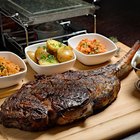
How to Cook Bison Chuck Roast

The Secret to Cooking Tender Pork

Perfect Way to Cook a Pork Chop in the ...

How to Make a Juicy Pork Tenderloin

Roasting Instructions for a Half Loin ...

How to Salt Cure Jerky

How to Cook Pork Hamonado

How to Know if Beef Cubes Are Bad

How to Cook Marinated Pork Loin From a ...
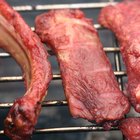
How to Use Grill Mates Pork Rub

How to Slow-Cook a Pork Roast in a Pot ...
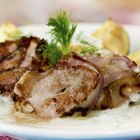
How to Cook Pork Tenderloin in a ...

How to Tell the Grain of Meats
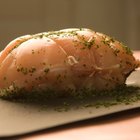
How to Braise Pork

How to Cook Jerk Pork in the Oven

How to Steam Pork Ribs
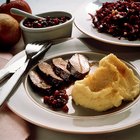
How to Make a Venison Rub

How Can I Tell If Lunch Meat Has Gone ...
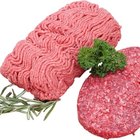
What Cuts of Meat Are Used for Ground ...

The Best Way to Prepare Bison Sirloin
References
Writer Bio
Shailynn Krow began writing professionally in 2002. She has contributed articles on food, weddings, travel, human resources/management and parenting to numerous online and offline publications. Krow holds a Bachelor of Science in psychology from the University of California, Los Angeles and an Associate of Science in pastry arts from the International Culinary Institute of America.
Photo Credits
Jupiterimages/Photos.com/Getty Images